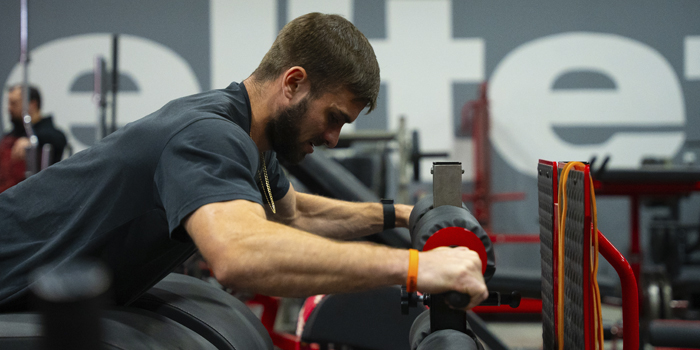
The Key to Long-Term Progression
For most of us, long-term improvements in strength will depend on two distinct factors: muscle mass and neurological factors. One without the other will only lead to reduced results. Yes, technique also plays a key role, but that should be something you are constantly striving to improve, regardless of your programming.
We have all seen the huge bodybuilders who can not lift what we would expect them to be able to (low neurological efficiency, high muscle mass) or the wiry Olympic lifters who can perform crazy feats of strength on the Olympic lifts but barely look like they lift (high neurological efficiency, low muscle mass). To truly maximize our performance, we must strive to maximize our muscle mass and our nervous system’s performance.
Anyone who has performed a well-structured peaking phase will have seen how quickly neurological gains can be made. Did you really get 30 pounds stronger on your bench press in six weeks? No. You just improved the ability of your nervous system to recruit your fast-twitch fibers and have them produce maximal force (through increased firing rate and de-sensitizing the GTOs, etc.). You could see improvements in performance in as little as two weeks when focusing primarily on improving neurological factors. After all, we are only upgrading our “software.”
Building Muscle
Building muscle is much slower. If muscle mass is your limiting factor, then there are not going to be any quick gains for you. We are asking our body to build completely new tissue, which can not happen at the same rate as improving neurological function, which is primarily enzymatic/receptor-based. The average intermediate male lifter will be lucky to put on one pound of muscle per month (assuming no use of performance-enhancing drugs (PEDs), and even then, keeping that rate up long-term is going to be tough.
This is why building muscle needs to be on your radar constantly. It just is not something you can meaningfully achieve in four to six weeks.
This is why the best long-term strength-building methods are those that are heavy enough to stimulate neurological gains but also provide enough volume to help us grow muscle.
Cluster training is possibly the best training method for this purpose, which is why I wrote a whole article about them here.
But doing nothing but clusters can be damn boring for some, which is why I wanted to introduce you to a method that is equally as effective – Contrast Sets.
Contrast Sets – What Are They and Why Should I Use Them?
Contrast Sets are a superior option for those who are more interested in hypertrophy or do not want to lift a high number of heavy singles. They give you the benefit of doing some heavier work but will involve a higher volume of work with more moderate loads (75-80 percent 1 Rep Max).
In its most basic form, a Contrast set involves doing a single heavy rep, followed by a short rest, before performing a higher rep set with a lower load. It will look something like this:
One rep at 90 percent 1 Rep Max
Rest for 20-30 seconds, during which you will remove some of the load from the bar.
4-6 reps at 80 percent 1 Rep Max
This plan would be ONE contrast set.
This contrast set is an effective method because the heavy single acts as a “potentiator” for the lighter drop-set that comes afterward. So not only does it get you some time under heavier loads, but you perform BETTER on the proceeding drop-set due to the higher level of neurological activation. And, of course, getting more volume at the same load is going to be great for hypertrophy by allowing us to accumulate more effective reps.
And let’s not forget the extra effective rep we get from doing the heavy single before the rep set. So, if we do three contrast sets using the above setup, we could get as many as 21 effective reps if we hit six reps on all our drop sets.
Contrast Sets – How to Program
We need to consider two separate factors with contrast sets: the heavy single and the drop set.
To be effective, the single rep needs to be heavy enough to stimulate a higher level of neurological activation but not so heavy that it creates excessive fatigue; otherwise, performance will suffer on the proceeding drop set. So, the heavy single should be loaded with anywhere from 85-92 percent 1 Rep Max.
We have a bit more wiggle room with the drop-set because, technically, any loading zone can be equally effective for hypertrophy, provided the same intensity level is reached. But, since we will use this method with compound movements and we want to focus on minimizing non-effective reps, we should not go lower than 75 percent 1 Rep Max. For most, this will be a weight they can hit 8-10 reps with.
The drop-set could be loaded as high as 80-82 percent 1 Rep Max. If it is any higher, not only will the load be too close to that of the heavy single, but we also will not get enough effective reps to stimulate hypertrophy maximally. 80-82 percent is a load most will be able to get four to six reps with. Considering the maximum number of reps we can get per set is six anyway, this works perfectly. Likewise, using a load of 80 percent 1 Rep Max means we do not accumulate any non-effective reps.
RECENT: Is Recomping the Holy Grail or A Waste of Time?
So, putting all that together, we have:
One rep at 85 percent 1 Rep Max
Rest 20-30 seconds
4-10 reps at 75-82% 1 Rep Max (rep number will depend on the load used)
Regarding volume, three or four contrast sets for a movement will give you more than enough stimulus for both strength and hypertrophy. You could perform contrast sets for another movement within the same workout, but it would be done for a different movement pattern (i.e., performing them on squat and then on bench press). These work really well for your main movement at the start of your workout before moving on to accessory movements using less intense loading patterns.
Contrast Sets – How to Progress
If I were to program contrast sets for several blocks, I would set the heavy single at the same percentage of 1 rep max for the whole block but then run a double progression model for the drop sets.
The double progression model simply involves having a target rep range for your drop sets and then increasing the load if you hit the upper limit of that rep range on all those work sets. For example, if your target was three sets of four to six at 80 percent, 1 Rep Max:
- Week 1 – 6 reps, 4 reps, 4 reps
- Week 2 – 6 reps, 5 reps, 5 reps (2 extra total reps)
- Week 3 – 6, reps, 6 reps, 6 reps (increase load by 1-2 percent next workout)
- Week 4 – 6 reps, 5 reps, 4 reps (with increased load)
You get the idea.
If we were to string this together for three training blocks, it could look like this:
Block 1 – 3-4 weeks
- Heavy Single – 85 percent 1 Rep Max
- Drop-sets – 6-10 reps at 75-77.5 percent 1 Rep Max
- Number of sets – 3
Block 2 – 3-4 weeks
- Heavy Single – 87/88 percent 1 Rep Max
- Drop-sets – 5-8 reps at 77.5-80 percent 1 Rep Max
- Number of sets – 4
Block 3 – 3-4 weeks
- Heavy Single – 90/91 percent 1 Rep Max
- Drop-sets – 3-5 reps at 80-82.5 percent 1 Rep Max
- Number of sets – 4
This progression would put you in a great position to put on a good amount of muscle but also provide enough neurological stimulation to jump into a heavier, more “pure strength” style program or even a realization/peaking phase for a competition.
Similarly, you could de-load for a few weeks with lighter loads and then repeat the above progression to continue making long-term strength and muscle gains.
Go Forth and Get Jacked
When aiming to get brutally strong, it is essential you keep your eye on the long game. If you want to keep progressing in the long term, getting more muscle mass will be a huge driver of that. So do not hang yourself up on jumping between pure strength methods/programs in the hope of rapid gains. Sure, you can make some fast neurological gains, but those will “max out” after about six weeks. After that, you will find yourself banging your head against a wall, trying to get more output out of an engine that simply is not big enough.
Contrast sets are one of the best “powerbuilding” methods that provide long-term, sustainable progress in both muscle mass and strength. You can apply them to any big, basic lift and can easily program them over time. If you follow the guidelines above, you will be on the road to consistent gains while getting jacked in the process!
Tom Sheppard is a strength and powerlifting coach based at the elitefts compound. As a coach, he has worked with professional athletes from a wide variety of sports worldwide, including rugby, baseball, MMA, and high-level powerlifters. Tom is the co-owner of Phoenix Performance and the Head Coach at Thibarmy. He also contributes content for companies such as elitefts and T-Nation. Tom presented at the 2022 and 2023 SWIS Symposium alongside some of the biggest names in the fitness industry.











